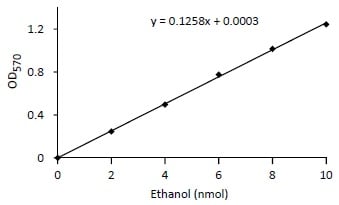Ethanol Assay Kit (ab65343)
Key features and details
- Assay type: Quantitative
- Detection method: Colorimetric/Fluorometric
- Platform: Microplate reader
- Assay time: 1 hr
- Sample type: Cell culture supernatant, Other biological fluids, Plasma, Serum, Tissue Extracts, Urine
- Sensitivity: 10 nM
Overview
-
Product name
Ethanol Assay Kit
See all Ethanol kits -
Detection method
Colorimetric/Fluorometric -
Sample type
Cell culture supernatant, Urine, Serum, Plasma, Other biological fluids, Tissue Extracts -
Assay type
Quantitative -
Sensitivity
> 10 nM -
Range
2 µM - 200 µM -
Assay time
1h 00m -
Product overview
Ethanol Assay Kit ab65343 provides a simple, rapid, and sensitive method for accurate quantification of ethanol concentration in a variety of biological samples such as serum, plasma, other body fluids, foods, beverages and growth media.
In the ethanol assay protocl, alcohol oxidase oxidizes ethanol to generate H2O2 which reacts with a probe to generate color (absorbance max 570 nm) and fluorescence (Ex/Em 535/587 nm).
The kit detects 0.1-10 ppm alcohol (~10-800 nM).
Ethanol assay protocol summary:
- add samples and standards to wells
- add reaction mix and incubate for 30 min at 37ºC
- analyze with microplate reader -
Notes
PLEASE NOTE: Extreme care should be taken to ensure that no alcohol vapors (ethanol, methanol, propanol) are in the laboratory air where this assay is to be performed. Alcohol vapors in the air will be rapidly absorbed by kit components resulting in very high background making the kit unusable. Laboratories where HPLC equipment and solvents are standing or where alcohol is used to wipe down laboratory benches or equipment are inappropriate locations to perform this assay.
Abcam has not and does not intend to apply for the REACH Authorisation of customers’ uses of products that contain European Authorisation list (Annex XIV) substances.
It is the responsibility of our customers to check the necessity of application of REACH Authorisation, and any other relevant authorisations, for their intended uses. -
Platform
Microplate reader
Properties
-
Storage instructions
Store at -20°C. Please refer to protocols. -
Components Identifier 100 tests Ethanol Assay Buffer WM 1 x 25ml Ethanol Enzyme Mix Green 1 vial Ethanol Probe (in DMSO, anhydrous) Red 1 x 200µl Ethanol Standard Yellow 1 x 500µl -
Research areas
-
Relevance
Alcohol (ethanol C2H5OH) is a clear colorless liquid rapidly absorbed from the gastrointestinal tract and distributed through the body. Ethanol has a depressive effect on the central nervous system and because of its psychoactive effects, it is considered a drug. Ethanol is metabolized by the body as an enerfy-providing carbohydrate nutrient, as it metabolized into acetyl CoA, an intermediate common with glucose than can be used for energy in the citric acid cycle (TCA) or for biosynthesis. Ethanol within the human body is converted into acetaldehyde by alcohol dehydrogenase and then into acetic acid by acetaldehyde dehydriogenase. Acetaldehyde, the product of the first step of the alcohol breakdown, is linked to most of the toxic clinical effects of alcohol. -
Alternative names
- Ethyl alcohol
Images
-
 Functional studies - ab65343 Zehendner C.M et al., PLoS One 8(5), Fig 5. Doi: 10.1371/journal.pone.0062628 Reproduced under the Creative Commons license http://creativecommons.org/licenses/by/4.0/
Functional studies - ab65343 Zehendner C.M et al., PLoS One 8(5), Fig 5. Doi: 10.1371/journal.pone.0062628 Reproduced under the Creative Commons license http://creativecommons.org/licenses/by/4.0/Ethanol in blood plasma was analyzed using ethanol assay kit (ab65343). Ethanol concentrations were determined 60 minutes after urethane administration in P0/1 mice and rats.
-
0.5 nmol of ethanol was added to diluted human biological fluids (1/10) and spiked samples were measured fluorimetrically (background subtracted, duplicates; +/- SD).
-
5 nmol of ethanol was added to diluted human biological fluids (1/10) and spiked samples were measured colourimetrically (background subtracted, duplicates; +/- SD).
-
Standard curves with background signal subtracted (duplicates; +/- SD).
-
Ethanol Standard Curve. Ethanol standard was diluted as described and the assay was performed according to the kit instructions.








